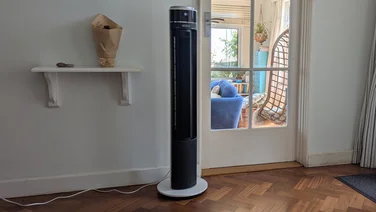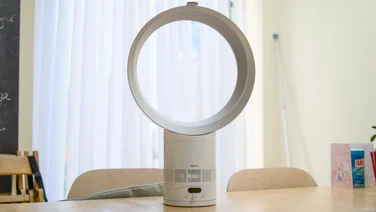To help us provide you with free impartial advice, we may earn a commission if you buy through links on our site. Learn more

It can be incredibly frustrating to discover mould, damp or mildew in your home. But can it negatively affect your health? Read on to find out. We also explore whether mould damages the materials, such as wallpaper, paint, wood or tiles, on which it has grown.
What is mould?
Mould is a microscopic fungus that thrives in damp and humid conditions. You may have spotted signs of mould in your bathroom, kitchen or other rooms in your home. The tell-tale signs of mould include visible fuzzy black, white or green patches that can appear anywhere. The most common places for mould to appear are in corners, on ceilings and in your shower or bathtub. But mould can also grow on windows, fabric, carpet, cardboard, pipes and insulation. As well as the visible signs, you may smell a damp, musty odour.
Plumbing expert Peter Clayton, from Trade Plumbing explains more “On most occasions mould and mildew are referred to together, especially because they are both a result of excessive moisture. However, unbeknown to most homeowners they are two separate substances with different characteristics. Mould is identified as patches of raised, furry spores that are green, red or black in appearance, commonly mould is confused with dirt. On the other hand, mildew is identified as grey powdery patches that are completely flat on the surface and often turn brown after a short period of time.”
“It is crucial to identify the difference between mould and mildew as although they are a similar fungus, mould can indicate a much larger issue and may therefore require a harsher treatment.”
While your home could be affected by mould all year round, winter and colder weather exacerbates the problem because of the fall in temperatures.
READ NEXT: The best mould removers to buy
What causes mould?
Mould is the result of excess moisture. When you step out of a particularly steamy shower or you’ve been cooking, you may notice the appearance of condensation on windows and mirrors. “Condensation is different from mould, but it’s important to note that condensation can cause mould,” says Paul Hambidge, Managing Director at Factory Direct Flooring. “To begin with, condensation usually looks like water droplets, or a ‘film’ of moisture and appears on surfaces like windows, cold walls, or even mirrors.”
Condensation happens when the temperature falls to what is known as the dew point, and water vapour in the air forms into droplets. When these water droplets come into contact with a cold surface, the droplets create dampness. Without adequate ventilation for the additional moisture to escape, this dampness creates the perfect environment for mould to grow. Chris Michael, the co-founder of Meaco, a leading dehumidifier manufacturer, expands on this, “Mould and mildew growth is caused mainly by the temperature and moisture levels in a space. If a room has a high moisture content internally, mould begins to grow on organic materials. This is why it is common to see mould growth in bathrooms as showering and bathing increases the moisture and humidity levels in that room. The rate at which it grows will be determined by the room’s relative humidity (RH). If it is above 68% RH, then the infestation will get larger, but if it is below 68% RH, then it will stop growing. If left untreated, it can cause damage to both health and home.”

While you may want to clean away the mould as soon as you see it, it’s actually more important to understand what’s causing the mould in the first place. It may be as simple as excess moisture and steam in the air following an everyday task such as bathing or cooking. If that’s the case, there are a few different, quick and easy solutions to help remove it. But a leak, either from a pipe, ceiling, roof or window, may require repairs to prevent mould from appearing again.
READ NEXT: The best dehumidifiers to buy
How can mould affect your health?
Mould exposure can cause respiratory infections, allergies and asthma, and if you already have any of these conditions it can often worsen the symptoms. For example, mould can trigger asthma attacks, coughing, wheezing and breathlessness by producing allergens and sometimes even toxic substances. These substances can cause an allergic reaction in the body.
Mould can also emit spores, cells and what are known as volatile organic compounds – chemical compounds – into the air. When these are inhaled or touched, it can cause a reaction, which may manifest itself as a runny nose, red eyes, sneezing or a skin rash.
According to the NHS, certain groups are more sensitive to mould than others, including older people, babies and children, individuals with existing skin problems such as atopic eczema, and those with respiratory problems, such as allergies and asthma. People with a weakened immune system should also stay away from mould and damp environments. But how can you prevent mould in the first place?
READ NEXT: The best air quality monitors to buy
How to prevent mould
As with most things, prevention is the best way to protect your home from mould. Taking the time to prevent mould from occurring in the first place can save you a lot of time, effort and energy in the long run.
Some of the easiest ways to prevent mould from growing or building up is to reduce the moisture in your home by opening windows, where possible, and using dehumidifiers. After showering, get into the habit of wiping down wet surfaces such as your shower wall or floor and avoid letting damp towels lie around for long periods.

When cooking, switch on an extractor fan or cooker hood. You’ll also want to watch out for any rainwater seepage after a heavy downpour, along with any possible plumbing leaks, and deal with them promptly. These steps will make it much more difficult for mould to find that ideal dark, warm and humid environment that it needs to spread.
READ NEXT: The best dehumidifier for drying clothes
How to treat mould
“To remove mildew, start by creating a solution of warm soapy water and gently rub with a soft sponge, you may find this is effective enough in completely removing the mildew and preventing its return,” suggests Peter Clayton. “However, if mildew reoccurs after using soapy water, then it’s a good idea to try a harsher solution. Start by mixing a solution of one cup bleach and three cups of water, then use the same method with a soft sponge and gently soak the area. This method can also be used to help remove mould. Similarly a mixture of one-part white vinegar and two parts water can be sprayed onto mould and mildew to kill the fungi.”
Jo Trotman, Marketing Manager at The Residence Collection, comments on ways to clean mould off windows safely, “There are two most common contributors to mould forming on windows and window sills, leaks and condensation. If mould does form on windows there are a few ways to safely remove it, this includes using soapy water to wipe away the mould, removing it with a wet rag then drying the area after to remove any moisture. Always throw away the rag after use and use rubber gloves and a mask where possible to stop the inhalation of the mould.”
Sometimes though, these tips will only provide temporary relief and you’ll need to look into the root causes as Chris Michael explains, “Root causes include reducing the moisture in the air, cleaning regularly and considering repeat offenders.”
- Reducing the moisture in the air – it’s humidity that causes damp and damp that causes mould and mildew. You can reduce the moisture in the affected room in a number of ways, including making sure you are ventilating the room properly. You can also use a dehumidifier, which is designed to suck the moisture out of the air.
- Make sure you clean regularly, paying particular attention to areas where you think mould and mildew might become a problem. You can use specialist mould and mildew cleaning products, or you might want to consider traditional remedies such as a white vinegar or baking soda solution, which are also great for breaking down the mould spores and getting rid of the problem.
- Consider replacing repeat offenders – if you have an ongoing problem with mould on your shower curtain, your bathroom blind or exposed wood areas, seriously consider replacing them. There’s a cost to this, of course, but replacing these items alongside better ventilation and a reduction in humidity will help to prevent reoccurring infestations.
Interestingly, the best way to deal with mould may not be what you think, as Paul Hambridge explains, “We recently commissioned an experiment that found mould to be one of the most common bacteria types that live on our floors, especially on carpets, and in kitchens and bathrooms. To our surprise, vacuuming was the most effective cleaning technique for reducing mould bacteria. In fact, in our experiment, hoovering cut mould by 71%. Meanwhile, floor wipes only reduced it by 30%.”
What if you live in rented accommodation and mould has appeared?
If you rent your home and you’ve tried to keep it as moisture-free as possible but mould is still occurring, then it’s the landlord’s responsibility to fix it. Both social and private landlords have a responsibility to ensure that the property is fit for habitation.
However, it’s crucial to note that the landlord may not be responsible if the cause of the mould is because of poor ventilation on your part. It may be worth contacting the Citizens Advice Bureau for advice and assistance on this topic if you find yourself in this situation.






